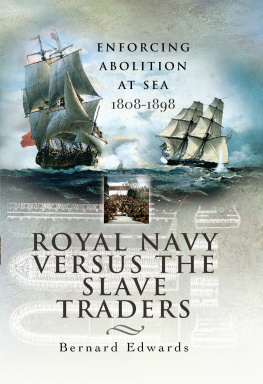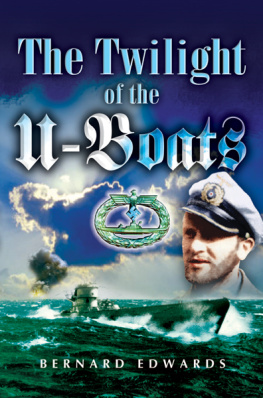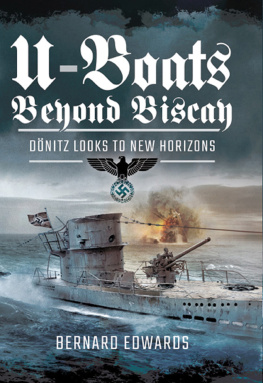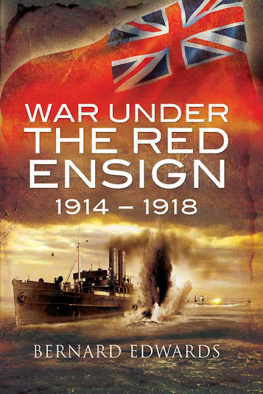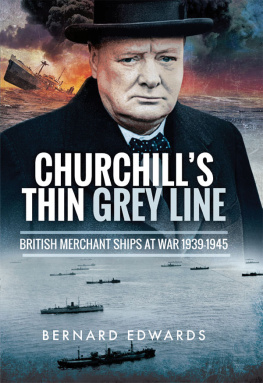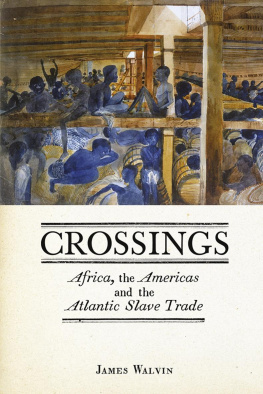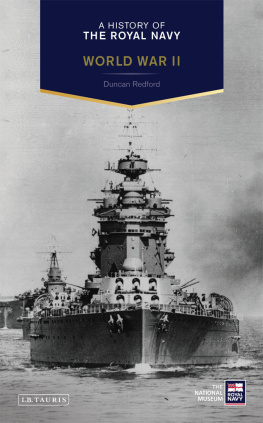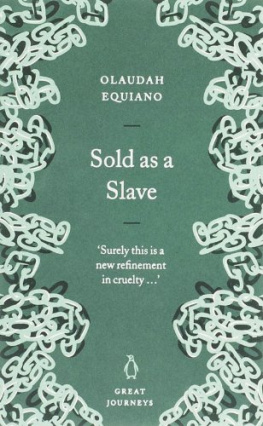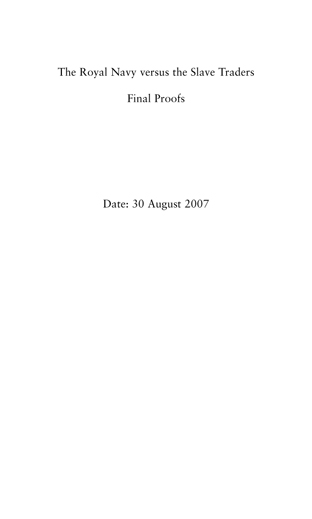

By the same author
Masters Next to God
They Sank the Red Dragon
The Fighting Tramps
The Grey Widow Maker
Blood and Bushido
SOS - Men Against the Sea
Salvo!
Attack and Sink
Dnitz and the Wold Packs
Return of The Coffin Ships
Beware Raiders!
The Road to Russia
The Quiet Heroes
The Twilight of the U-boats
Beware the Grey Widow Maker
Death in the Doldrums
Japans Blitzkrieg
War of the U-Boats

First published in Great Britain in 2007 by
Pen & Sword Maritime
an imprint of
Pen & Sword Books Ltd
47 Church Street
Barnsley
South Yorkshire
S70 2AS
Copyright Bernard Edwards, 2007
ISBN 978-1-84415-633-7
The right of Bernard Edwards to be identified as Author of this Work
has
been asserted by him in accordance with the Copyright, Designs and
Patents Act 1988.
A CIP catalogue record for this book is
available from the British Library
All rights reserved. No part of this book may be reproduced or transmitted in any form or by any means, electronic or mechanical including photocopying, recording or by any information storage and retrieval system, without permission from the Publisher in writing.
Typeset in 11/13 Sabon by
Lamorna Publishing Services
Printed and bound in England by Biddles Ltd
For a complete list of Pen & Sword titles please contact
PEN & SWORD BOOKS LIMITED
47 Church Street, Barnsley, South Yorkshire, S70 2AS, England
E-mail: enquiries@pen-and-sword.co.uk
Website: www.pen-and-sword.co.uk
Thanks to Almighty God and next to the English nation, whose laws relieved us from the bondage in which we have been held.
Robert Peart, Slave, Spanishtown, Jamaica 1838
Authors Note
On 16 March 1807, thanks largely to the persistent efforts of William Wilberforce, Thomas Clarkson and Granville Sharp, the British Parliament passed the Abolition of the Slave Trade Act.
The politicians led the way, but it was left to the men of the Royal Navys African Squadron to face the guns of the slavers and the killer diseases that haunted the Dark Continent. This they did with exceptional bravery and devotion to duty, standing alone to end an evil that had plagued Africa for so many centuries.
The object of this book is not to re-write history, but to clear away the fog of accusations and recriminations that surround the slave trade.
The author wishes to thank Africa Christian Action of Claremont, South Africa for its generous help in obtaining illustrations for this book.
Contents



A Family Trait
When, lo, out of the darkness there was light, There in the sea were England and her ships.
John Masefield
In the gathering dusk of 5 November 1940 Convoy HX 84 was in mid-Atlantic, and had reached the point of no return in its eastbound passage. The comparative safety of American waters lay far astern, and ahead, nearly a thousand miles over the horizon, was Fortress Britain, ringed by marauding U-boats, and beckoning urgently. For HX 84 there was no turning back.
Steaming closed up in nine columns abreast, the thirty-seven deep-loaded merchantmen forming the convoy were enjoying a spell of rare good weather for the time of the year. The normally turbulent ocean was quiescent, the sky showing patches of blue, and the horizon was as sharp as a whetted knife. For the men manning the open bridges of the merchant ships, balaclava-red and duffel-coated against the cold of the approaching night, this was a welcome relief from the usual savagery of the North Atlantic in winter, and they were savouring it to the full. But to the man ultimately responsible for their safety the unnatural calm spelled danger.
Captain Edward Fogarty Fegen, RN, commanding HX 84s sole escort vessel, the armed merchant cruiser Jervis Bay, had good reason to be ill at ease. His ageing ex-passenger liner command, armed with seven obsolete 5.9s firing over open sights, was all that stood between HX 84 and the hordes of a determined enemy. On that day, Fogarty Fegen would have sold his soul for the cover of a roaring Atlantic gale.
And as the last of the daylight faded, Fegens worst fears were realised. Over the horizon came the German pocket-battleship Admiral Scheer, her director-controlled 11-inch gun turrets belching smoke and flame.
The 12,000-ton Admiral Scheer was one of Hitlers powerful Panzerschiff class, built specifically to hunt down and destroy British merchant shipping. She was armed with eight 5.9-inch and six 11-inch guns the finest Krupps could supply she had a top speed of 26 knots, and a cruising range of 19,000 miles without refuelling. Under the command of Kapitn-zur-See Theodor Krancke, the Admiral Scheer had left the Baltic on 24 October, and three days later slipped through the Denmark Strait into the North Atlantic undetected. Kranckes orders were to mount an attack on British convoys in the North Atlantic, which at this time were said to be only lightly escorted due to the withdrawal of many of the Royal Navys ships to the Mediterranean following the Italian declaration of war. HX 84 was to be Kranckes first target.
For the Jervis Bay the odds seemed insurmountable, but Edward Stephen Fogarty Fegen, descended from the Irish kings, son of an admiral, and nurtured in the fires of the Great War of 1914-18, recognised only one answer to the danger threatening. Ordering the convoy to scatter, he sent his men to their action stations, and steamed straight for the Admiral Scheer, his 5.9s spitting defiance.
What followed was predictable. The German guns outranged those of the Jervis Bay by nearly 7000 yards, and the slow, high-sided British auxiliary was on fire and crippled long before she came close enough to land a shell on the Admiral Scheer. Fortynine-year-old Captain Edward Fogarty Fegen died on the bridge of his ship with his face to the enemy.
The hero of the Jervis Bay was only four years old when in May 1887 his father, Frederick Fogarty Fegen, was serving as a lieutenant in the screw corvette HMS Turquoise, one of the slave-hunters of the Royal Navys African Squadron. The Turquoise, armed with twelve 64-pounder muzzle-loading rifles, had been assigned to patrol the east coast of Africa in the region of Zanzibar, where Arab slave traders were known to be active.
On 28 May, when the Turquoise was cruising between Zanzibar and the neighbouring island of Pemba, Lieutenant Fogarty Fegen was sent away in the corvettes steam pinnace with a crew of eight and an Arab interpreter. His orders were to intercept, board and search any Arab slaving dhows attempting to break out into the Indian Ocean by sailing north of Pemba. It was after sunset when the pinnace reached the Fundu Gap, a navigable channel favoured by the dhows between Pembas small satellite islands of Fundu and Njao. Fegen brought the pinnace to an anchor off the entrance to the Gap, and settled down to wait out the night.
Next page
